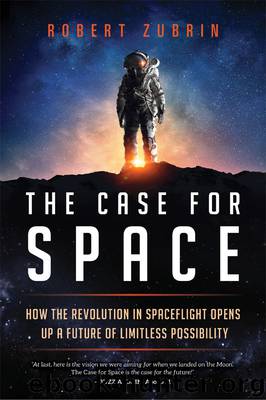The Case for Space by Robert Zubrin;

Author:Robert Zubrin;
Language: eng
Format: epub
ISBN: 9781633885356
Publisher: Penguin Random House LLC (Publisher Services)
SATURN EXPRESS
It seems to me that the Breakthrough Initiative needs a near-term mission that can act as a transition to its visionary goal of interstellar travel. I have a concept for this, which I call “Saturn Express.” The basic idea is to create an ultrafast sail craft that can enable near-term exploration of the outer solar system while demonstrating the potential for more advanced incarnations to go to 550 AU, and then the stars.
So consider: at 1 AU, solar light pressure is nine micronewtons per square meter. So a sail craft with an areal density of 1.5 g/m2 would experience an acceleration away from the sun of 0.006 m/s2, which is exactly the same as the gravitational acceleration exerted by the sun at 1 AU. These two forces would balance, at 1 AU and all other distances, since they both go down with the inverse square of the distance. Therefore, such a craft released with escape velocity from Earth would move out in a straight line along the tangent to Earth's orbit at the Earth's orbital speed, which is 30 km/s, or 6 AU/yr. It would thus be able to reach Jupiter in about 0.8 years, Saturn in 1.5 years, Uranus in 3.2 years, and Neptune in 5 years.
Saturn would be an excellent first target because it is of such great interest to exobiology. If we have a sail with an areal density of 1 g/m2 (one micron thick, which should be doable) and an area of one hundred square meters, it will have a mass of one hundred grams. This leaves fifty grams for the spacecraft. The configuration could be like a parachute, with the sail craft like the parachutist astern of the sail, which would be billowing out ahead of it. This would be passively stable, with the concave side of the parachute pointing toward the sun, which would also be toward the Earth once it was out far enough, providing a high gain reflector. The sail craft would mount a strobe light, blinking with a power of one hundred watts for one millisecond every one thousand seconds. It would have an average power consumption of 0.0001 watts, using up 0.88 watt-hours per year. By looking at it with Hubble or Webb, we could track its speed via its Doppler shift. If the craft could be targeted to fly behind Enceladus, we conceivably might be able to look for the spectrum of organic molecules launched into orbit by its plumes.
That's the basic idea. By leaving the multimegawatt laser for later, Breakthrough Starshot could have something flying soon, on a budget well within the means of Yuri Milner. It would be a profound demonstration of fast sail technology, directly traceable to more advanced versions with potential for interstellar missions.
I sent a write-up laying out this plan to the Breakthrough Starshot Foundation in 2018. Let's hope they go for it.
Download
This site does not store any files on its server. We only index and link to content provided by other sites. Please contact the content providers to delete copyright contents if any and email us, we'll remove relevant links or contents immediately.
| Aerodynamics | Aircraft Design & Construction |
| Astronautics & Space Flight | Avionics |
| Gas Dynamics | Propulsion Technology |
Whiskies Galore by Ian Buxton(41885)
Introduction to Aircraft Design (Cambridge Aerospace Series) by John P. Fielding(33064)
Small Unmanned Fixed-wing Aircraft Design by Andrew J. Keane Andras Sobester James P. Scanlan & András Sóbester & James P. Scanlan(32744)
Craft Beer for the Homebrewer by Michael Agnew(18146)
Turbulence by E. J. Noyes(7942)
The Complete Stick Figure Physics Tutorials by Allen Sarah(7312)
Kaplan MCAT General Chemistry Review by Kaplan(6868)
The Thirst by Nesbo Jo(6834)
Bad Blood by John Carreyrou(6559)
Modelling of Convective Heat and Mass Transfer in Rotating Flows by Igor V. Shevchuk(6392)
Learning SQL by Alan Beaulieu(6213)
Weapons of Math Destruction by Cathy O'Neil(6152)
Man-made Catastrophes and Risk Information Concealment by Dmitry Chernov & Didier Sornette(5926)
Digital Minimalism by Cal Newport;(5669)
Life 3.0: Being Human in the Age of Artificial Intelligence by Tegmark Max(5479)
iGen by Jean M. Twenge(5368)
Secrets of Antigravity Propulsion: Tesla, UFOs, and Classified Aerospace Technology by Ph.D. Paul A. Laviolette(5311)
Design of Trajectory Optimization Approach for Space Maneuver Vehicle Skip Entry Problems by Runqi Chai & Al Savvaris & Antonios Tsourdos & Senchun Chai(5012)
Pale Blue Dot by Carl Sagan(4917)
